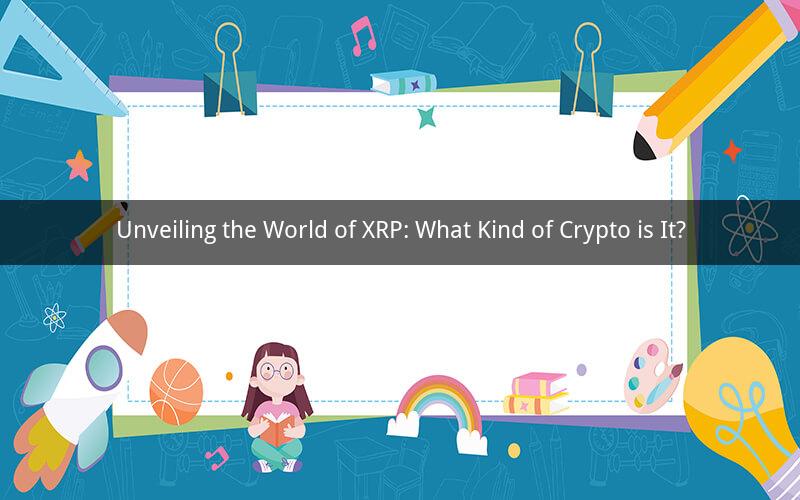
Introduction:
In the vast world of cryptocurrencies, XRP has emerged as a significant player, captivating the attention of investors and enthusiasts alike. But what exactly is XRP, and how does it fit into the crypto landscape? This article delves into the essence of XRP, exploring its unique features, technological aspects, and potential future.
Section 1: Understanding XRP
1.1 Definition and Origin
XRP is a digital asset designed to facilitate fast and low-cost international money transfers. Created by OpenCoin (now known as Ripple Labs), XRP was launched in 2012 as a complement to RippleNet, a global network of financial institutions that use XRP to process cross-border payments.
1.2 Unique Features
XRP stands out from other cryptocurrencies due to several key features:
- Speed: XRP transactions are processed in seconds, making it one of the fastest cryptocurrencies available.
- Scalability: XRP can handle a high volume of transactions per second, far exceeding Bitcoin and Ethereum.
- Low Fees: XRP transactions incur minimal fees, making it an attractive option for cross-border payments.
Section 2: XRP's Role in the Crypto Ecosystem
2.1 RippleNet and Financial Institutions
RippleNet is a global network of financial institutions that use XRP to facilitate real-time international payments. By partnering with banks and payment providers, Ripple aims to reduce the costs and time associated with cross-border transactions.
2.2 XRP Ledger
The XRP Ledger is the underlying blockchain technology that powers XRP. It is designed to be highly efficient and secure, with a focus on scalability and low transaction costs. The XRP Ledger is unique in its ability to process transactions in parallel, further enhancing its speed and efficiency.
Section 3: XRP's Market Performance
3.1 Price Volatility
XRP, like many cryptocurrencies, has experienced significant price volatility over the years. Its value has surged and plummeted multiple times, reflecting the dynamic nature of the crypto market.
3.2 Market Position
As of 2023, XRP is the fourth-largest cryptocurrency by market capitalization. Its position in the market is a testament to its potential as a disruptive force in the global financial system.
Section 4: XRP's Controversies and Legal Issues
4.1 Legal Actions
XRP has faced legal challenges, primarily from the U.S. Securities and Exchange Commission (SEC). The SEC accused Ripple Labs of selling unregistered securities, leading to a prolonged legal battle that has captivated the crypto community.
4.2 Impact on XRP's Reputation
The legal issues surrounding XRP have raised concerns about its legitimacy and future prospects. However, many believe that the outcome of the legal battle will ultimately determine XRP's trajectory.
Section 5: XRP's Potential Future
5.1 Adoption by Financial Institutions
As Ripple continues to expand its partnerships with financial institutions, the adoption of XRP is likely to increase. This could lead to greater liquidity and stability in the XRP market.
5.2 Technological Advancements
Ripple is continuously working on improving its technology, including developing new products and services that leverage XRP's unique features. These advancements could further solidify XRP's position in the crypto ecosystem.
5.3 Regulatory Environment
The regulatory environment surrounding cryptocurrencies remains uncertain. However, as governments and regulatory bodies continue to grapple with the challenges of regulating digital assets, XRP's future may depend on how well it adapts to these evolving regulations.
Conclusion:
XRP is a digital asset with a unique set of features that make it an attractive option for cross-border payments. Its role in the crypto ecosystem, coupled with its potential for growth, makes it a compelling asset for investors and enthusiasts. While XRP faces challenges, including legal issues and market volatility, its future remains bright, especially as Ripple continues to expand its partnerships and enhance its technology.
Questions and Answers:
1. What is the primary purpose of XRP?
XRP is designed to facilitate fast and low-cost international money transfers, making it an ideal asset for cross-border payments.
2. How does XRP differ from other cryptocurrencies like Bitcoin and Ethereum?
XRP stands out due to its speed, scalability, and low transaction costs. Unlike Bitcoin and Ethereum, XRP is specifically designed for payment purposes and operates on a different blockchain technology.
3. What is RippleNet, and how does it relate to XRP?
RippleNet is a global network of financial institutions that use XRP to process cross-border payments. It aims to reduce the costs and time associated with international money transfers.
4. How has XRP's price performance impacted its market position?
XRP has experienced significant price volatility, which has both contributed to and been influenced by its market position. Despite the volatility, XRP remains one of the top cryptocurrencies by market capitalization.
5. What are the potential future developments for XRP?
XRP's future may depend on several factors, including the outcome of the legal battle with the SEC, Ripple's partnerships with financial institutions, and the ongoing development of its technology.